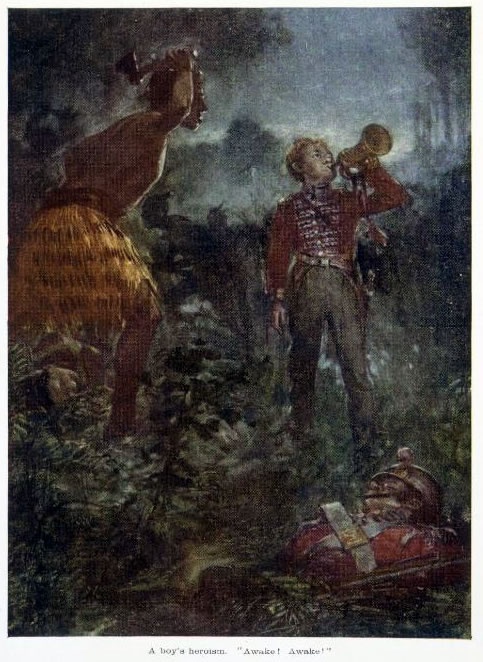
In this highly romanticised painting, young bugler William Allen sounds his horn to give warning of the dawn attack at Boulcott’s Farm, Hutt Valley. Redcoat soldiers lie dead in the foreground and left background, and the boy is about to be killed by a blow from an axe.
Paintings like this were not uncommon at this time. Māori were presented as violent and ‘savage-like’. This representation of the event was designed to both elicit sympathy from the settler community and mythologise the ‘heroic’ behaviour of the British military.
In Louis Ward’s Early Wellington, Allen’s death at Boulcott Farm was described as follows:
During the fighting at Boulcott’s Farm, at the Hutt, on the 16th May, 1846, a bugler named Allen, belonging to the 58th Regiment, espied a body of rebels coming stealthily forward to attack the detachment of troops stationed there. He was in the act of sounding an alarm on the bugle to give warning to the regiment, when he was struck by a tomahawk on his right arm. He placed the bugle in his left hand, when that limb was also struck. Then, placing the bugle between his knees, he effected his purpose, but was instantly brained with the tomahawk. His heroic act saved the whole detachment from being massacred.
An account of this incident also appeared in J.G. Wilson’s Early Rangitikei. The following lines taken from Early Rangitikei were used in a poem by Archdeacon A.V. Towgood that was published in the Wellington Girls’ College Reporter magazine:
He raised his bugle, and with clarion sound,
The clear Reveille filled the sleeping vale;
Awake! Awake! The rocks and hills around
Sent back the echoes in the dawning pale.
Allen’s bugle was carried away as a trophy. It was later recovered in one of Te Rangihaeata’s deserted camps at Battle Hill.

Community contributions